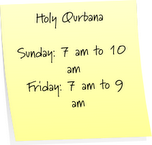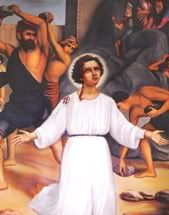History of Indian Orthodox Church
 The Indian Orthodox Church (also known as the Malankara Orthodox Church, Orthodox Church of the East, Malankara Orthodox Syrian Church, Orthodox Syrian Church of the East), is a prominent member of the Oriental Orthodox Church family. The Church traces its origins to St. Thomas the Apostle, who came to India in AD 52, established the Church and suffered martyrdom. The head of the Indian Orthodox Church is the Catholicos of the East and Malankara Metropolitan whose seat is at Kottayam, Kerala, India. The Church has dioceses and churches in most parts of India as well as in the United States, Canada, United Kingdom, Western Europe, Persian Gulf nations, Malaysia, Singapore, Australia and New Zealand. The official title of the head of the Church is the "Catholicos of the East, Catholicos of the Apostolic throne of St. Thomas, and the Malankara Metropolitan". The present Catholicos of the East and Malankara Metropolitan is H. H. Mar Baselios Mar Thoma Didymos I, who was enthroned on October 31, 2005 at Parumala Church by the Holy Synod amidst the Holy Eucharist. The Church, though modern in its vision and outlook, keeps the traditional Orthodox faith and liturgy. It accepts the first three Ecumenical Synods. The liturgy now in use is the translation of the liturgy adopted from the Antiochian Church in the 17th century. However, the liturgical rites are uniquely Indian. Today the Church uses liturgy in Malayalam, Hindi, and English. The Indian Orthodox community inherited many aspects of Indian civilization and they are as any other member of any other community in India, in their customs, manners, and life style. The Church has a Theological Seminary at Kottayam, Kerala, which was established in AD 1815. Another seminary is situated in Nagpur, Maharashtra. The later was established fairly recently in the later part of the 20th century. The Church takes an active role in various ecumenical activities at national and international levels. It is a member of the World Council of Churches. Famous theologians such as Mar Paulose Gregorious, Mar Geevarghese Osthathios, Rev. Fr.V.C. Samuel, and Rev. Dr. K. M. George, who contributed to the negotiations between the Oriental and Byzantine churches, belong to this church. The Indian Orthodox Church also participated in the Ecumenical Council of Oriental Orthodox Churches held in Addis Ababa, in AD 1965.
The Indian Orthodox Church (also known as the Malankara Orthodox Church, Orthodox Church of the East, Malankara Orthodox Syrian Church, Orthodox Syrian Church of the East), is a prominent member of the Oriental Orthodox Church family. The Church traces its origins to St. Thomas the Apostle, who came to India in AD 52, established the Church and suffered martyrdom. The head of the Indian Orthodox Church is the Catholicos of the East and Malankara Metropolitan whose seat is at Kottayam, Kerala, India. The Church has dioceses and churches in most parts of India as well as in the United States, Canada, United Kingdom, Western Europe, Persian Gulf nations, Malaysia, Singapore, Australia and New Zealand. The official title of the head of the Church is the "Catholicos of the East, Catholicos of the Apostolic throne of St. Thomas, and the Malankara Metropolitan". The present Catholicos of the East and Malankara Metropolitan is H. H. Mar Baselios Mar Thoma Didymos I, who was enthroned on October 31, 2005 at Parumala Church by the Holy Synod amidst the Holy Eucharist. The Church, though modern in its vision and outlook, keeps the traditional Orthodox faith and liturgy. It accepts the first three Ecumenical Synods. The liturgy now in use is the translation of the liturgy adopted from the Antiochian Church in the 17th century. However, the liturgical rites are uniquely Indian. Today the Church uses liturgy in Malayalam, Hindi, and English. The Indian Orthodox community inherited many aspects of Indian civilization and they are as any other member of any other community in India, in their customs, manners, and life style. The Church has a Theological Seminary at Kottayam, Kerala, which was established in AD 1815. Another seminary is situated in Nagpur, Maharashtra. The later was established fairly recently in the later part of the 20th century. The Church takes an active role in various ecumenical activities at national and international levels. It is a member of the World Council of Churches. Famous theologians such as Mar Paulose Gregorious, Mar Geevarghese Osthathios, Rev. Fr.V.C. Samuel, and Rev. Dr. K. M. George, who contributed to the negotiations between the Oriental and Byzantine churches, belong to this church. The Indian Orthodox Church also participated in the Ecumenical Council of Oriental Orthodox Churches held in Addis Ababa, in AD 1965. Administration
The Church has its head quarters at Kottayam, Kerala. The present head of the Indian Orthodox church is H.H. Baselius Mar Thoma Didymos I. The official title of the head of the Church is "the Catholicos of the East seated on the throne of St Thomas and the Malankara Metropolitan".
The Church is ruled and governed by the Church Constitution of 1934. True to the orthodox Christian tradition, the Indian Orthodox Church employs an administrative system which is a perfect blend of episcopacy and democracy.
Catholicos of the Eastand Malankara MetropolitanH.H. Baselius Mar Thoma Didymos I
The Church is divided into 25 dioceses with a bishop heading each diocese. The Malankara Syrian Association is the parliament of the Church which is a body of bishops and elected laity and clergy representatives from all the parishes. This Association meets on special occasions to take important decisions pertaining to the entire church.
The Association also elects a Managing Committee for carrying out administrative activities on behalf of the Association. The number of laity members of this committee is double that of the clergy, which indicates the participative nature of laity in church matters. The Episcopal Synod comprising of all the Bishops of the church is the authority regarding Faith, Order and Discipline. The Synod is also responsible to install the Catholicos designated by the Association.
Faith and Liturgy
The Church, though modern in its vision and outlook, keeps the traditional Orthodox faith and liturgy. It accepts the first three Ecumenical Synods. In earlier days, the liturgy used by the Church was adopted from the Persian Church, which had to be abandoned at the Portuguese compulsion at the end of 16 th century. The liturgy now in use is the translation of the Syrian liturgy adopted from the Antiochian Orthodox Church in the 17th century. Today the Church uses Malayalam as liturgical language in Kerala, respective local languages in other parts of India and English in outside India.
The Indian Orthodox community inherited many aspects of Indian civilization and they are as any other member of any other community in India, in their customs, manners and life style.
History
Since the Old Testament times Kerala had trade relations with West Asia. These trade routes later enabled Christianity to reach Kerala that the Apostle Thomas preached the Gospel to the locals (which included Jewish settlers in Kerala), baptized many, ordained priests and founded seven churches. These seven villages became epicenters of Indian Christianity and other parishes started evolving from these seven mother parishes.




